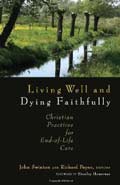 Living Well and Dying Faithfully – Christian Practices for End of Life Care, John Swinton & Richard Payne (Editors)
Living Well and Dying Faithfully – Christian Practices for End of Life Care, John Swinton & Richard Payne (Editors)
Eerdmans, 2009, (ISBN 978-0-8028-6339-3), pp 311, paperback £16.99
This collaborative collection of essays edited by Swinton who teaches practical theology in the University of Aberdeen and Payne who is professor of medicine and divinity at Duke Divinity School is the result of a three day conversation between scholars about the significance of Christian presence in this particular area of health care. The book is skillfully edited and carefully organized into two parts: part one is entitled Practices of Living to Die Well and the second part is Practices of Healing and Hope. The editors introduce and conclude the twelve essays and there is a comprehensive index. The volume would certainly have been strengthened with the inclusion of a resource list of core texts and pointers for further reading.
Some of the presuppositions that undergird the essays are familiar. Death has been largely medicalised in society and dominated by its practitioners and languages. The individual is set within the context of a cultural world where medicine appears to be all powerful easily overlooks autonomy. It follows that our systems of healthcare fail to engage creatively with the patient experience. Our own questions therefore should come more to the fore: how do we want to die? Where do we want to die? Who would we choose to help us during this particular stage of our lives? Finally, the reader is reminded throughout the book that one dies the way one lives and it is of fundamental importance that issues surrounding end of life care are put into a broader perspective of what it means to be human and what it means to be healthy.
All the essays focus themselves on the practices and skills that we need to help us to understand, embrace and practice death. In this exploration the Christian tradition is understood as fundamentally important as it enables us to make sense of both living and dying. In a foreword Stanley Hauerwas reminds the reader that theology is the hard won wisdom of Christian people across time and as such it is a Christian imperative that all experience particularly dying should be determined by our confidence in the love of God (p xii). The core experience therefore is that dying is a spiritual event with medical implications and for the Christian death should be shaped by the language of faith. So the book proceeds to offer a multi-layered perspective on various forms of Christian practices as they relate to end of life care. These include forgiveness (chapters 2 and 4); sacraments (chapter 4); love (chapter 1); compassion (chapter 7 and 9); hope (chapter 10); dignity (chapter 11); justice (chapter 12); spiritual formation (chapter 1) and healing (chapter 10).
The authors succeed in arguing forcibly that death requires a wider narrative that transforms stories told by medicine by placing them in a different context and engaging them in forms of conversation that draw out fresh perspectives and new promises. For Christians therefore the meaning of suffering is discerned within a particular theological narrative of creation and redemption, death and resurrection. This is a narrative that transforms our assumptions about the meaning of death and what it might mean to die well.
As the art of living is explored and we are encouraged to be honest in the expression of our hopes and fears there is some particularly powerful material in this book about imagination: ‘’Imagination is a pattern of possibilities, fostered within a community by the stories and the correlative communities that make it what it is’’ (page 271). It is through our imagination we make sense of the world and make decisions about how we should respond to our experiences. It is imagination that allows us to anticipate and understand what is going on in and around us based on our previous experience and expectation.
This reviewer might criticize the text on the grounds that it fails to ask how far the language of Christian theology connects with the experience of those who are grieving. We underestimate, perhaps, the gap and the oddly privatized nature of our grammar. However, it is the very security founded on Christian theology that calls theorists and practitioners to re-fund our imagination so that challenges us to ask what needs to change: what needs to be different in order that we might live well and die faithfully. Within this context theology may just be the key that unlocks our imagination for new horizons, encounters and Christian practices. It is the doctrine and theology that makes this book is a powerful and coherent argument for radical change.
James Woodward
Published in Modern Believing Volume 51:3 July 2010 pp73-75